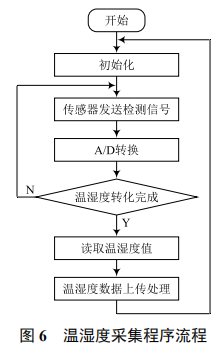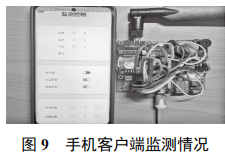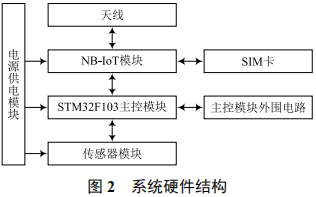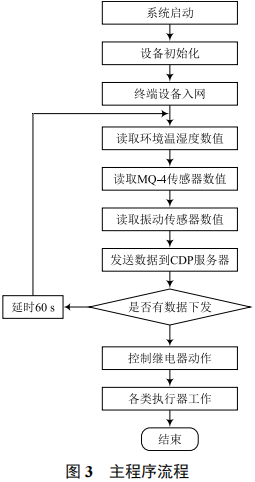Ding Song, Wang Changsheng, Zheng Ping
(Anhui University of Science and Technology, School of Electrical and Information Engineering, Huainan, Anhui 232001)
Abstract: Comprehensive utility tunnels are the lifelines of cities. To ensure the stable and safe operation of comprehensive utility tunnels, a monitoring system based on NB-IoT wireless transmission technology is designed to address the issues of real-time and accurate public environment monitoring within the tunnels. This system collects environmental parameter information inside the tunnel through relevant sensors, processes the environmental parameters using the STM32F103 main control module, and finally uploads the environmental parameters to the cloud platform via NB-IoT wireless transmission technology. The information is presented in real-time through a web page and mobile app, achieving effective monitoring and control of the internal environmental parameters of the comprehensive utility tunnel.
Keywords: Environmental Monitoring; Comprehensive Utility Tunnel; STM32F103; NB-IoT Technology; Cloud Platform; Upper Computer
Classification Number: TP277; TU990 Document Identification Code: A Article Number: 2095-1302 (2022) 09-0070-03
Currently, the scale of underground comprehensive utility tunnel construction in cities is increasing, and the internal environment of the tunnels is complex, with various engineering pipelines concentrated together. Among them, the maintenance of gas pipelines is particularly important. If an accident occurs, it not only affects the normal operation of urban life but also threatens the safety of inspection personnel in the tunnel. To avoid the hazards caused by damage and leakage of gas pipelines within the tunnel, it is crucial to conduct real-time monitoring of the overall environmental conditions inside the comprehensive utility tunnel to ensure real-time, automatic, and accurate monitoring of the internal environment conditions. Therefore, it is necessary to monitor relevant environmental parameters such as gas concentration, temperature and humidity, and vibration signals in real-time. When these environmental parameters exceed warning values, timely alarms should be sent to the relevant management departments, control units, and dispatch inspection personnel for immediate repairs.
The internal management status of modern urban underground utility tunnels is complex and lacks intelligent, effective, reliable, and economical methods and means for environmental monitoring. Addressing this issue, this paper combines the advantages of the emerging wireless communication technology Narrowband Internet of Things (NB-IoT) to build a real-time intelligent monitoring and management system for comprehensive utility tunnels, effectively monitoring various environmental parameters inside the tunnels. Through simulation applications, the effectiveness and feasibility of this system have been verified, providing an effective intelligent monitoring solution for the intelligent monitoring, management, and daily maintenance of urban underground utility tunnels.
The overall structure of the intelligent monitoring system for urban underground comprehensive utility tunnels is shown in Figure 1. The overall system consists of the following parts: the collection and processing part for environmental parameters such as temperature, humidity, harmful gases, and vibration information, the remote transmission part of environmental parameter information, and the upper computer monitoring management PC and mobile terminal parts.
The hardware terminal of the comprehensive utility tunnel environmental monitoring system mainly consists of the power supply module, environmental parameter information collection sensor module, STM32F103 main control module, and NB-IoT wireless transmission module, which are responsible for system hardware power supply, information collection, core control, and wireless communication, as shown in Figure 2.
The main control module uses the STM32F103C8T6 chip, which not only features ultra-low frequency, low power consumption, and low cost, but also has a large storage capacity and rich peripheral circuit modules. It adopts a high-performance ARM Cortex-M32 core, supporting the expansion of various sensor modules, fully meeting the complex and variable environment of underground comprehensive utility tunnels.
This system monitors the environment inside the comprehensive utility tunnel, using temperature and humidity sensors, MQ-4 sensors, and vibration sensors for data collection. The environmental temperature and humidity monitoring uses the DHT11 digital low-power sensor, which communicates with the STM32 via a One-Wire bus, with measurement accuracy ranges of 0 to 50 °C and 20% to 90%, and strong stability against interference. The MQ-4 sensor is used for monitoring harmful gases, mainly detecting methane and other harmful gases generated by gas leaks within the tunnel, providing rapid response and ensuring the safety of inspection personnel. Terrain changes can cause settlement, vibration, or shaking of the tunnel, leading to potential safety hazards for internal equipment. Therefore, the SW-420 normally closed vibration detection sensor is selected, which operates at a voltage range of 3.3 to 5V. In a non-vibration state, it outputs a low level, while in a vibration state, it outputs a high level, allowing the detection of vibrations or shaking.
3.3 NB-IoT Wireless Communication Module
NB-IoT technology is primarily built on cellular communication networks, characterized by low network costs, low power consumption, and deep coverage, making it a widely applied emerging communication technology globally. This system uses the BC95 series engineering module, the first NB-IoT R13 standard protocol module launched by Shanghai Esky Communication Co., which is a high-performance, low-power, strong penetration, and stable wireless communication module. It can connect with various terminal devices, supports multiple network protocols, is compact in size, operates at a power supply voltage of 3.3V, with a sleep power consumption of 5μA and a working power consumption of 6mA. This enables long-term real-time communication with the cloud platform for the environmental monitoring system in the comprehensive utility tunnel, ensuring real-time data transmission and display.
The software design of the system mainly consists of the environmental collection terminal in the tunnel and the STM32F103 main control. The development software uses MDK5 and C language for programming.
The system starts by initializing GPIO ports, USART serial ports, and ADC analog-digital conversion; it connects the terminal device to the BC95 communication module with the cloud platform and awaits data transmission; it reads temperature and humidity, gas concentration, and vibration sensor parameters, sending these parameters to the CDP server and checking if there are commands from the server. If there are commands, the relay is activated to start various actuators; if not, it delays for 60 seconds to complete data collection and uploading. The main program flow of the system is shown in Figure 3.
4.2 Collection Terminal Program Design
The environmental parameter information collection terminal consists of MQ-4 sensors, vibration sensors, and temperature and humidity sensors, which transmit the collected environmental information via NB-IoT wireless transmission to the upper computer, achieving real-time monitoring of the tunnel. The MQ-4 sensor first detects the concentration of natural gas in the air, and the STM32 performs A/D conversion on the collected information, determining if the natural gas concentration exceeds the reference value. If it exceeds the reference value, an alarm is uploaded to alert relevant inspection personnel; if it is below the reference value, the data is uploaded and stored, and the system returns to re-collect data. The program design flow of the MQ-4 sensor is shown in Figure 4.

In a sleep state, the vibration sensor outputs a low level, indicating that the vibration switch is off, while the green indicator light is on, completing data uploading and storage after a delay, and returning to re-collect data; when vibration occurs, the vibration switch opens, outputting a high level, while the green indicator light is off, and an alarm is uploaded. The program design flow of the vibration sensor is shown in Figure 5.

The temperature and humidity sensor sends a detection signal, begins data collection, converts the collected temperature and humidity data into analog signals readable by the main control module, and uploads and stores the data before returning to re-collect.

5 System Testing
After completing the hardware and software design of the system, a monitoring platform is built, devices are connected, and powered on. The system undergoes collection testing in a simulated environment to verify the feasibility of the monitoring system. The real-time variation curves are shown in Figure 7, and the upper computer real-time monitoring interface is shown in Figure 8. Under normal environmental conditions, the environmental parameters remain unchanged; when the surrounding environment is altered, the environmental parameter curves exhibit jumps. At this time, the temperature displayed on the upper computer’s real-time monitoring interface is 30 °C, humidity is 77%, gas concentration is 11%, and no vibration occurs.


To ensure the objectivity of the experiment, the real-time monitoring effect of the mobile client is verified again. By adjusting the set alarm threshold and changing the vibration environment, the monitoring situation of the mobile client is shown in Figure 9. The temperature, humidity, and natural gas concentration in the tunnel exceed the threshold, and when the vibration signal changes from 0 to 1, the system alarms, and the LED indicator lights up.

6 Conclusion
To avoid hazards caused by uncontrollable factors leading to changes in the internal environment of comprehensive utility tunnels, a real-time effective monitoring system is designed. The system utilizes NB-IoT wireless transmission technology, compensating for the limitations of wired transmission. By deploying highly sensitive sensors within the tunnel and displaying data in real-time on the upper computer, real-time, accurate, and rapid monitoring and management of the internal environment of the tunnel are achieved, ensuring the safety of the tunnel and the normal operation of urban life.
References
[1] Zhang Hao. Research on the Design Ideas of Intelligent Comprehensive Utility Tunnel Monitoring and Alarm System [J]. Modern Building Electrical, 2017, 8(4): 17-20.
[2] Li Rui, Fu Haocheng. Analysis of the Design of Comprehensive Utility Tunnel Monitoring and Alarm System [J]. Intelligent Building Electrical Technology, 2016, 10(3): 67-70.
[3] Zhou Ruyi. Research and Design of Underground Comprehensive Utility Tunnel Monitoring and Alarm System [D]. Xi’an: Chang’an University, 2019.
[4] Jiang Fuhao, Shan Chaoying, Liu Ye, et al. Intelligent Fire Hydrant Detection and Management System Based on NB-IoT [J]. Electronic Technology and Software Engineering, 2020, 27(5): 23-24.
[5] Lin Kaitao, Cai Jiayu, Xu Wei, et al. Agricultural Plant Protection UAV Based on STM32 [J]. Automation Technology and Application, 2019, 38(6): 140-143.
[6] Liu Hui, Chen Long. Application of IoT Technology in Smart Agriculture Water-saving Irrigation [J]. China Science and Technology Information, 2018, 30(12): 61.
[7] Guo Bao, Liu Yi, Zhang Yang. Discussion on NB-IoT Wireless Throughput and Low Power Consumption Technology [J]. Mobile Communication, 2017, 41(11): 79-84.
[8] Wang Fenghua, Hu Chunjie, Niu Zhixing, et al. Real-time Monitoring System of Soil Moisture Based on NB-IoT [J]. Water-saving Irrigation, 2020, 45(1): 53-55.
[9] Zhang Liyuan, Wu Guangfu, Zhou Heng, et al. Design of Self-powered Fire Monitoring System Based on NB-IoT [J]. Radio Communication Technology, 2018, 44(5): 506-511.
[10] Qiu Yi, Guo Yijing, Liu Ting. Design and Implementation of Smart Manhole Cover Monitoring System Based on NB-IoT [J]. Internet of Things Technology, 2020, 10(9): 16-18.
Ding Song (1997—), male, from Anqing, Anhui, master’s student, research direction in IoT development and application.








